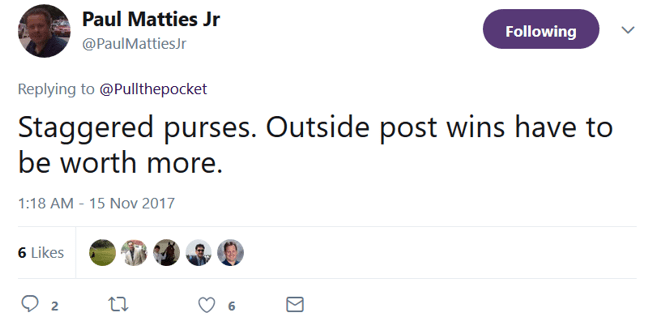Can half-mile tracks create a better product?
In Part I we analyzed the disadvantage half-mile tracks possess in terms of field depth and handle generation. In Part II we offer a couple solutions.
by Dean Towers
“I wouldn’t bet that place with Monopoly money,” said one bettor to me a few weeks ago. He was speaking of a half-mile racetrack where the racing has little movement; races that resemble a merry-go-round that all-too-often end with a $9 exacta and $21 trifecta. Some of racing’s seasoned customers like this man have that feeling, so one wonders what other bettors the sport needs to attract might think.
In Part I we examined why post bias is such a threat on the smaller ovals, and by way of a quick summary, we noticed that on half-mile tracks early speed increasingly comes from the best posts, and this shortens “field depth” dramatically. This presents the gambler (and fan) with fewer potential race outcomes, and consequently lowers handles, resulting in smaller revenues to harness racing.
In Part II we’ll have a look at a couple of tactics that may help increase real field size, and provide bettors and fans with a more interesting product to watch and wager on.
Let’s head to Pennsylvania
When we analyzed the data in Part I we noticed that the outside post positions at smaller tracks yield so few (fewer than 5 per cent) horses making the lead, and a meagre number of horses landing in the top three slots at the half. When compared to the mile or 7/8’s mile tracks, well, there simply was no comparison.
However, when we look at another smaller track – in this case the 5/8’s oval at The Meadows – the data is pretty astounding. Here’s data from The Meadows, along with comparison data from the Meadowlands, Mohawk, Yonkers and Northfield.
Incredibly, the Pennsylvania racetrack —even though only a 5/8’s — has a completely different post bias in terms of early speed.

• More horses reach the lead at the half from the outside two posts than at the Big M or Mohawk (and they score nine wide).
• More horses reach the lead at the half from the nine post than they do from the rail (this could be partially due to the poor inside at The Meadows on off tracks).
It is obvious that the driving colony at The Meadows has little trouble taking a shot at the lead from the outside posts.
Meanwhile, when we look at horses that are 1st through 3rd at the half, the numbers are equally interesting.

Yes there’s a bias to the middle of the gate, but again, at The Meadows, the two outside posts provide a driver with a chance to use his horse’s speed at greater frequency than even the rail.
What’s different at The Meadows compared to some other racetracks? Something not new, but not as frequently talked about in the sport in this day and age: The Meadows has a slanted starting gate. The outside post has a 15-foot advantage.
Can half-mile track issues be fixed with something so simple and often bandied about in this sport like a staggered gate? Probably not, but as The Meadows illustrates, experimenting with it at different staggers and running the numbers over a season might not be a bad idea.
Pay the Man (or Woman)
The lack of movement on smaller tracks, as well as so many horses from the outside going straight to the back of the bus was a discussion on social media recently, and one response caught my eye. It was from Paul Matties. Paul is (primarily) a thoroughbred player who took down the $800,000 first prize in the National Handicapping Championship last year.

Paying more, or adding a bonus for outside post wins has been talked about before (and tried at The Meadows at one point, as far as I know), so it’s not new. But it sure is logical, isn’t it? In theory, adding such a bonus should encourage drivers to take a shot more often with live horses from the outside because money is a perfect incentive in a sport that races for it.
Further, if the policy was tweaked to bonus outside horses that are in the top three at the half (that go on to win) this could encourage even more movement. For example, if a driver leaves from the seven and tucks his horse in the five hole but feels he has a lapful of horse, he’s more likely to move on the first turn to challenge the leader. This not only injects pace into the race, it creates a vibrant early flow with a live horse first over.
I think the driving colony at Yonkers is fantastic, and I’d love to see the result of the Bartletts and MacDonalds and others devising a strategy from the outside posts. I bet we’d see some entertaining racing, and at the very least we’d not have to take out the red pen and cross off a horse from the seven post so quickly.
Don’t stop experimenting
Bob Pandolfo referenced some interesting statistics he gleaned from his keen eye on the Yonkers distance races recently. He believes the slower pace over the longer distances brings more back markers into the race. He also professes that the trailers encourage more early movement, and it can result in some bigger prices.
It’s early, and the jury is still out but there could be something happening that’s positive for handles in these races (aside from the bigger pools due to export).
Longer distances and races of this nature are something seasoned players are not used to, and many dislike the format. But when we think back to when the Meadowlands opened – with horses coming from everywhere – seasoned players complained, too. Years later, of course, bigger prices through more field depth drew customers demanding betting value to the Big M pools and they never looked back.
Summing up
We’ve spoken before about the need for more movement, and more pace in harness racing (see the passing lane article here). This is buttressed in a 1998 study by Piron & Smith which said it’s racing’s job to “bring together horses and purse money in a way to encourage people to bet on those horses,” and to maximize this purse money, there should be a goal to create competitive races that, “in a perfectly handicapped race, all horses would finish in a dead heat.”
That is not going to happen in even an ideal world, but I hope you read both part I and II and digested some of the statistics regarding outside posts on smaller tracks with this in mind.
I am sure there are many ideas on how to inject pace and movement into races on half-mile tracks; to incentivize drivers from outside posts to be more aggressive; to make not only watching, but betting harness racing on small tracks more worthwhile. If you have any, please let us at HRU know by sending along your comments.
Note – A huge thank you to long-time bettor and harness fan Ray Schell and his database for the above numbers.
















